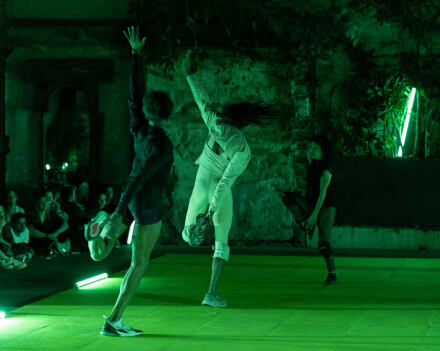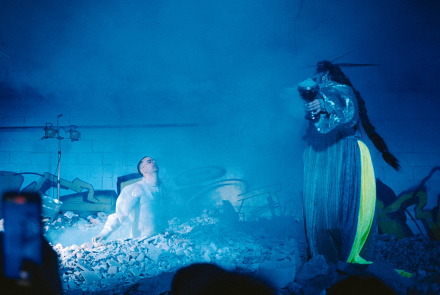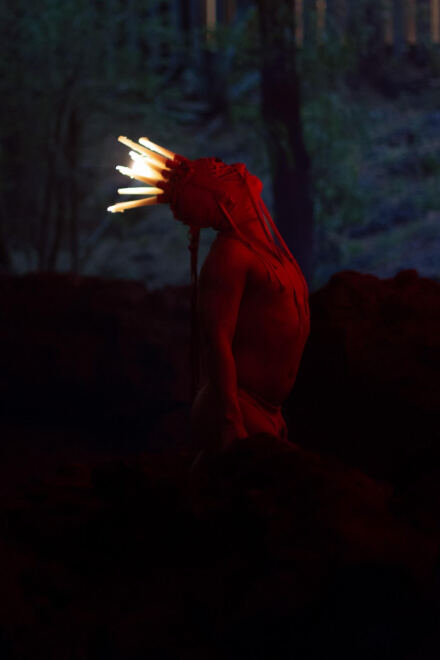Diego Vega Solorza, Dorje (2019), via Pablo Astorga
On April 18 in Mexico City, TONO, a new festival dedicated to time-based work, held its inaugural two-week program. Partnering with museums and galleries around the city, TONO presented a range of experimental performance art, video installations, and dance performances by local, regional, and international artists. With each performance filled completely at capacity with a diverse audience including collectors from Mexico City and New York, other curators and artists, and students, the festival laid its foundations as an invaluable space for stimulating dialogues surrounding the relationship between various time-based mediums in the contexts of one another.
NAAFI, ATLACOYA: Agua Triste del Lago de Texcoco (2023), via Rodrigo Alvarez
Inspired by the rich history of performance art and experimental video and film in Mexico, founder and curator Samantha Ozer hoped not only to create a platform that could reflect and unite the past and present of time-based works but provide further institutional support and focus to these types of productions. “I thought this would be a nice opportunity to fully focus on the relational aspects of the medium and fully platform artists that are here in Mexico with other international artists who have never shown in Mexico or Latin America for the first time” Ozer tells Art Observed. In the debut two-week festival, the main program included major cultural spaces around the city including the Museo Anahuacalli, Museo de Arte Moderno, Museo Ex Teresa Arte Actual, Centro de Cultura Digital, Laboratorio Arte Alameda, Casa Margarita, and General Prim. The satellite program took place at a variety of participating galleries in Mexico City. Supported by notable curators and directors at a range of international art institutions, TONO hopes establish itself as a leading platform to connect Mexican audiences with international artists and uplift Mexican artists to have global presentations.

Ligia Lewis, Deader Than Dead (2020), via Brenda Jauregui
Interested in the relationship between sound and moving image, specifically through the lens of dance and music, the inaugural theme “rhythm” examines the way rhythm formally orders and creates structure and how artists manipulate and communicate moments of disorder through form. Acting as a thread to examine group dynamics, social structures, and political acts, the video installations and performances investigated channels of connection between the individual and the collective, as well as interspecies and ecological relationships.
“There were very specific political moments in some of the music. There was also a strong emphasis on its relationship with ecology and the natural flows and rhythms, exploring how music is a form of communication between us, other species, and the earth itself. In this sense, the theme allowed the artists to tread into a lot of different directions” Ozer says. Performance artists include Ligia Lewis, whose multi-faceted work inquires expressions of humor in the body and the meeting of sonic and visual metaphors with the material, and Jao Moon, a dancer and choreographer who investigates conversations surrounding gender identity and moments of ritual and resistance. Video installations include Cecilia Bengolea’s Shelly Belly Inna Real Life, 2020, which explores the influences of culture and nature on dancehall communities in Jamaica and Arthur Jafa’s akingdoncomethas, 2018, which combine 100 minutes of found footage of Black church services across the US to communicate and celebrate embodied expressions of hope and belief.
Jao Moon, The Lifetime of Fire (2022), via Guillermina Cetkovich Bakmas
Through these practices which simultaneously reference, reflect, and respond to context and environment in real time, artists and audiences can examine and reconnect with the way temporality is experienced, both individually and as a collective. “The significance of time-based practices such as video, dance, performance,” Ozer says, “is that an artist is able to dictate the time in which a viewer spends with their work.” Often accustomed to dulling time’s passing through the hyper-saturated virtual distractions in the digital age, there is an ever-pressing need for audiences to participate in experimental practices that might engage the viewer – as much as the artist – with the elasticity of time.
Ozer plans for TONO to be an annual event in Mexico City and is excited to explore other possible iterations with pop-up exhibitions and grant programs, hoping to inspire new threads of research and support younger artists to continue working in time-based mediums.
– H. Zhang
Read More
Project Site [TONO]
This entry was posted on Monday, May 15th, 2023 at 4:35 pm and is filed under Art News, Featured Post, Show. You can follow any responses to this entry through the RSS 2.0 feed. You can leave a response, or trackback from your own site.



